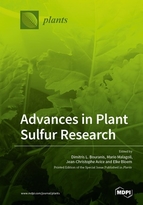Advances in Plant Sulfur Research
A special issue of Plants (ISSN 2223-7747).
Deadline for manuscript submissions: closed (1 March 2019) | Viewed by 51936
Special Issue Editors
Interests: plant physiology; plant nutrition physiology; sulfur physiology; sulfur nutrition; sulfur use efficiency; fertilization with sulfur-containing fertilizers; sulfur interactions with iron, nitrogen, and phosphorus, focusing on graminaceous species
Special Issues, Collections and Topics in MDPI journals
Interests: sulfur nutrition; glucosinolates; sulfur-containing metabolites; gaseous S compounds; hydrogensulfide; cysteine; glutathione; biotic stress; abiotic stress; sulfur and fungal pathogens; medicinal plants
Interests: plant physiology; plant nutrition; sulfur nutrition; sulfur and abiotic stresses; sulfur fertilization; sulfur and tolerance to heavy metals; sulfur in grapevine cultivation
Special Issues, Collections and Topics in MDPI journals
Interests: nutrient use efficiency; plant nutrition; nitrogen and sulfur fertilization; plant responses to abiotic stress; plant senescence; seed quality; remobilization of nutrients; proteolytic mechanisms
Special Issue Information
Dear Colleagues,
Sulfur is an essential nutrient required for plant growth and development, therefore sulfur containing fertilizers are nowadays used worldwide to increase crop yield and quality. Crops can suffer from sulfur deficiency due to environmental protection and decreased emission of sulfur dioxide to the atmosphere which limited the availability of sulfate as input in the large scale agriculture. The emergence of sulfur deficiency in such productive systems attracted the scientific attention and triggered significant research interest. As a consequence, in the last 25 years a tremendous boost has taken place in all aspects of plant sulfur research. Milestones in this field include so far the central role of sulfate transporters in response to sulfur availability, sulfur as a part of plant metabolic network, sulfotranferases, impact of sulfur on N2 fixation of legumes, role of sulfur-compounds in abiotic and biotic stress tolerance, sulfur nutrition and assimilation in crop plants, sulfur interactions in crop ecosystems, sulfur in biotic interactions of plant, the concept of sulfur-induced-resistance, the molecular links between metals in the environment and plant sulfur metabolism, role of sulfate and sulfur-rich compounds in heavy metal tolerance and accumulation.
Despite the amazing amount of the rapidly accumulating information, there are still open questions and challenges on this fascinating field. For example, the regulation of gene expression in response to sulfur regime is an important aspect of sulfur metabolism in plants and it is still subject of intense research. On the other hand, S contributes to plant tolerance under stressful agricultural conditions. For instance, NO acts as a signal molecule and induces salt tolerance in plants by enhancing S assimilation and synthesis of S compounds and modulating the activity of antioxidant enzymes. Interactions between NO and S assimilation regulates GSH synthesis for the adaptation of plants to stressful environments. The physiological and molecular mechanisms with which NO induces S assimilation and how it interacts with other plant hormones and nutrients to achieve plant salt tolerance are among the open research topics.
Therefore, in this special issue articles (original research papers, perspectives, hypotheses, opinions, reviews, modeling approaches and methods) that focus on S metabolism and its regulation including biochemistry, physiology, genes, proteins, metabolites, nutrition and environment, at all levels comprising transcriptome, proteome, metabolome and epigenome studies, plant microbiome, sulfur use efficiency, sulfur interaction with nutrients and/or hormones, sulfur-status and plant health, senescence, whole plant studies, field trials and agronomics in model plants, crop plants, trees, aquatic plants and native species are most welcome.
Prof. Dr. Dimitris L. Bouranis
Prof. Dr. Mario Malagoli
Prof. Dr. Jean-Christophe Avice
Guest Editors
Manuscript Submission Information
Manuscripts should be submitted online at www.mdpi.com by registering and logging in to this website. Once you are registered, click here to go to the submission form. Manuscripts can be submitted until the deadline. All submissions that pass pre-check are peer-reviewed. Accepted papers will be published continuously in the journal (as soon as accepted) and will be listed together on the special issue website. Research articles, review articles as well as short communications are invited. For planned papers, a title and short abstract (about 100 words) can be sent to the Editorial Office for announcement on this website.
Submitted manuscripts should not have been published previously, nor be under consideration for publication elsewhere (except conference proceedings papers). All manuscripts are thoroughly refereed through a single-blind peer-review process. A guide for authors and other relevant information for submission of manuscripts is available on the Instructions for Authors page. Plants is an international peer-reviewed open access semimonthly journal published by MDPI.
Please visit the Instructions for Authors page before submitting a manuscript. The Article Processing Charge (APC) for publication in this open access journal is 2700 CHF (Swiss Francs). Submitted papers should be well formatted and use good English. Authors may use MDPI's English editing service prior to publication or during author revisions.
Keywords
- sulfur metabolism
- regulation of sulfur metabolism
- sulfur in signalling systems
- sulfur deficiency
- sulfur nutrition physiology
- reactive sulfur species
- sulfur use efficiency
- sulfur uptake efficiency
- sulfur utilization efficiency
- sulfur remobilization
- sulfur interactions










